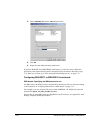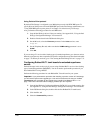
7-24 INSTALLING INTEL TELEPHONY COMPONENTS
Configuring Calling Name Identification
Depending on your ISDN provider, Calling Name Identification is delivered in an Information
Element (IE) either when the incoming call is offered (in the SETUP message) or on a
subsequent FACILITY message.
When you order Calling Name Identification, request the following information from your
provider:
Message in which the calling name is delivered
IE in which the calling name is delivered
Offset within the IE where the calling name field begins
Length of the calling name field
You specify this information via the TeleVantage Administrator for each ISDN PRI span. See
“Setting location and Caller ID settings” in Chapter 5 in Administering TeleVantage for details.
Enabling IE-based audio connection
On ISDN PRI spans, audio connection is based on Information Elements (IEs) that accompany
PROGRESS messages.
When turned off (the default), TeleVantage connects audio on all ISDN PRI calls only
with the IEs 1 and 8 on PROCEEDING, SETUP_ACK, and ALERTING messages.
When this feature is turned on, TeleVantage connects audio on all ISDN PRI calls
regardless of PROGRESS IEs.
You can turn this feature on or off by changing the
Connect Audio on Proceeding setting via
the TeleVantage Administrator for each ISDN PRI span. See “Optimizing your ISDN settings”
in Chapter 5 in Administering TeleVantage.
Configuring TeleVantage for delivery of overlapped DNIS digits
By default, TeleVantage is configured for complete delivery of DNIS digits on the SETUP
message. Some European switches deliver DNIS digits one at a time after the SETUP message
(overlapped digits.)
You can make changes to the DNIS digit delivery settings
OverlappedDNIS and DNISWaitTime
via the TeleVantage Administrator for each ISDN PRI span. See “Optimizing your ISDN
settings” in Chapter 5 in Administering TeleVantage.
If you have ISDN BRI boards, go to the next section. Otherwise, perform any other required
board-specific configuration steps described in the table on page 7-19. When you are done, go
to “Test-starting the Intel Dialogic drivers” on page 7-33.


















